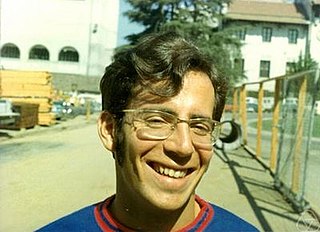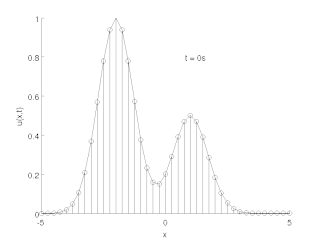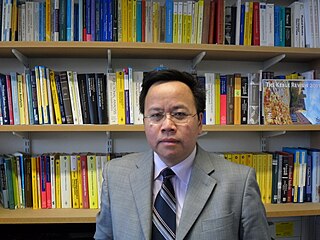
In mathematics, a partial differential equation (PDE) is an equation which involves a multivariable function and one or more of its partial derivatives.
Numerical methods for partial differential equations is the branch of numerical analysis that studies the numerical solution of partial differential equations (PDEs).
Heinz-Otto Kreiss was a German mathematician in the fields of numerical analysis, applied mathematics, and what was the new area of computing in the early 1960s. Born in Hamburg, Germany, he earned his Ph.D. at Kungliga Tekniska Högskolan in 1959. Over the course of his long career, Kreiss wrote a number of books in addition to the purely academic journal articles he authored across several disciplines. He was professor at Uppsala University, California Institute of Technology and University of California, Los Angeles (UCLA). He was also a member of the Royal Swedish Academy of Sciences. At the time of his death, Kreiss was a Swedish citizen, living in Stockholm. He died in Stockholm in 2015, aged 85.

Stanley Osher is an American mathematician, known for his many contributions in shock capturing, level-set methods, and PDE-based methods in computer vision and image processing. Osher is a professor at the University of California, Los Angeles (UCLA), Director of Special Projects in the Institute for Pure and Applied Mathematics (IPAM) and member of the California NanoSystems Institute (CNSI) at UCLA.

The method of lines is a technique for solving partial differential equations (PDEs) in which all but one dimension is discretized. By reducing a PDE to a single continuous dimension, the method of lines allows solutions to be computed via methods and software developed for the numerical integration of ordinary differential equations (ODEs) and differential-algebraic systems of equations (DAEs). Many integration routines have been developed over the years in many different programming languages, and some have been published as open source resources.
Lloyd Nicholas Trefethen is an American mathematician, professor of numerical analysis and until 2023 head of the Numerical Analysis Group at the Mathematical Institute, University of Oxford.
A parabolic partial differential equation is a type of partial differential equation (PDE). Parabolic PDEs are used to describe a wide variety of time-dependent phenomena in, i.a., engineering science, quantum mechanics and financial mathematics. Examples include the heat equation, time-dependent Schrödinger equation and the Black–Scholes equation.

Randall J.. LeVeque is a Professor of Applied Mathematics at University of Washington who works in many fields including numerical analysis, computational fluid dynamics, and mathematical theory of conservation laws. Among other contributions, he is lead developer of the open source software project Clawpack for solving hyperbolic partial differential equations using the finite volume method. With Zhilin Li, he has also devised a numerical technique called the immersed interface method for solving problems with elastic boundaries or surface tension.
Eli L. Turkel is an Israeli applied mathematician and currently an emeritus professor of applied mathematics at the School of Mathematical Sciences, Tel Aviv University. He is known for his contributions to numerical analysis of Partial Differential equations particularly in the fields of computational fluid dynamics, computational electromagnetics, acoustics, elasticity and image processing with applications to first Temple ostraca and recently deep earning for forward and inverse problems in PDEs,
Finite difference methods for option pricing are numerical methods used in mathematical finance for the valuation of options. Finite difference methods were first applied to option pricing by Eduardo Schwartz in 1977.
Burton Wendroff is an American applied mathematician known for his contributions to the development of numerical methods for the solution of hyperbolic partial differential equations. The Lax–Wendroff method for the solution of hyperbolic PDE is named for Wendroff.

Gui-Qiang George Chen is a Chinese-born American-British mathematician. Currently, he is Statutory Professor in the Analysis of Partial Differential Equations, Director of the Oxford Centre for Nonlinear Partial Differential Equations, and Director of the EPSRC Centre for Doctoral Training in Partial Differential Equations at the Mathematical Institute, and Professorial Fellow at Keble College, located at the University of Oxford, as well as Life Member of Clare Hall, University of Cambridge.
The Kansa method is a computer method used to solve partial differential equations. Its main advantage is it is very easy to understand and program on a computer. It is much less complicated than the finite element method. Another advantage is it works well on multi variable problems. The finite element method is complicated when working with more than 3 space variables and time.
Irena Lasiecka is a Polish-American mathematician, a Distinguished University Professor of mathematics and chair of the mathematics department at the University of Memphis. She is also co-editor-in-chief of two academic journals, Applied Mathematics & Optimization and Evolution Equations & Control Theory.
Sara Zahedi is an Iranian-Swedish mathematician who works in computational fluid dynamics and holds an associate professorship in numerical analysis at the Royal Institute of Technology (KTH) in Sweden. She is one of ten winners and the only female winner of the European Mathematical Society Prize for 2016 "for her outstanding research regarding the development and analysis of numerical algorithms for partial differential equations with a focus on applications to problems with dynamically changing geometry". The topic of Zahedi's EMS Prize lecture was her recent research on the CutFEM method of solving fluid dynamics problems with changing boundary geometry, such as arise when simulating the dynamics of systems of two immiscible liquids. This method combines level set methods to represent the domain boundaries as cuts through an underlying uniform grid, together with numerical simulation techniques that can adapt to the complex geometries of grid cells cut by these boundaries.
Eugene Isaacson (1919–2008), was a US mathematician who pioneered modern numerical analysis. He was a mathematics and physics graduate of City College in New York, he then entered the graduate program in mathematics at New York University under the supervision of Kurt Otto Friedrichs, gaining a PhD on water waves on sloping beaches in 1949. His academic career was then spent at the Courant Institute until his retirement.
Joseph E. Oliger was an American computer scientist and professor at Stanford University. Oliger was the co-founder of the Science in Computational and Mathematical Engineering degree program at Stanford, and served as the director of the Research Institute for Advanced Computer Science.
Christoph Schwab is a German applied mathematician, specializing in numerical analysis of partial differential equations and boundary integral equations.
Gunilla Kreiss is a Swedish applied mathematician and numerical analyst specializing in level-set methods and numerical methods for partial differential equations, especially for problems arising in fluid dynamics including two-phase flow, shear flow, and Burgers' equation. She is professor of numerical analysis in the Department of Information Technology, Division of Scientific Computing at Uppsala University, and editor-in-chief of BIT Numerical Mathematics.

Heinz Otto Cordes was a German-American mathematician, specializing in partial differential equations (PDEs). He is known for the Aronszajn–Cordes uniqueness theorem for solutions of elliptic PDEs.





